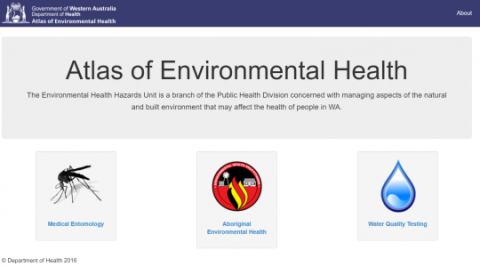
The Western Australian Atlas of Environmental Health was developed by Gaia Resources for the Department of Health, with support from the Cooperative Research Centre for Spatial Information. The initial launch of the system in April 2016 (read our launch blog here) focused on the Medical Entomology module (which in turn has a focus on mosquito management), but also includes the Aboriginal Environmental Health and Water Quality Testing modules, which are yet to be launched.
Our team undertook the design, development and some of the training for the project, all the while working alongside Departmental staff (like we outlined here). The Atlas includes a web based system (built in Django with PostGRES and PostGIS), along with a mobile app for both Android and iOS operating systems. These technologies are paired with a Help system that is a relatively simple WordPress site, and the whole system runs on Amazon Web Services infrastructure.
Since the launch for Western Australia, the Atlas has been taken up by the Department of Health and Human Services in Victoria, and forms the backbone for mosquito management activities within both States.
In July, 2018 Gaia Resources worked with the Department of Health and Human Services (Victoria) to build enhancements into the Atlas of Environmental Health. Following on from work in 2017, this centered around three priority areas: adult reporting data management, a ground surveillance mobile application for remote offline data entry, and an API (Application Interface) for integration with the Department’s PowerBI analytics system.
The most recent Ground Surveillance Module mobile app provides an efficient means for EHO’s in Victoria to inspect properties and rapidly record information on location, mosquito breeding site details and take geotagged photographs. The purpose of the app is to provide greater coverage and visibility of mosquito breeding patterns to health officials.
Integration through a RESTful API means that DHHS staff can combine data from the Atlas with other departmental datasets and gain new insights.
A series of blogs have been published that outline our work across these projects:
- Launch Blog (May, 2016) – https://archive.gaiaresources.com.au/atlas-environmental-health/
- Expansion into Victoria (February, 2017) – https://archive.gaiaresources.com.au/expanding-atlas-victoria/
- Research into treatment workflows in the field (April, 2017) – https://archive.gaiaresources.com.au/mosquito-treatments/
- Updated medical entomology functionality (May, 2017) – https://archive.gaiaresources.com.au/atlas-environmental-health-update/
- Loading historical records into the Atlas (July, 2017) – https://archive.gaiaresources.com.au/historical-mosquitoes/